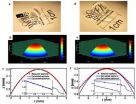(Press-News.org) Washington, D.C.— Certain types of bacteria responsible for causing urinary tract infections (UTIs), the second-most-common infection in the United States, are becoming more difficult to treat with current antibiotics, according to new research from Extending the Cure (ETC), a project of the Center for Disease Dynamics, Economics & Policy. ETC released the research via its online ResistanceMap, an online tool created to track changes in antibiotic drug use and resistance. This year, ResistanceMap features analysis using ETC's Drug Resistance Index, a way for non-experts to track changes in antibiotic effectiveness.
Using an index that tracks antibiotic resistance over time, researchers found that the available arsenal of drugs used to treat UTIs are losing their overall effectiveness, with the overall share of resistant bacteria increasing by over 30% between 1999 and 2010. There are currently about five drug classes used to treat UTIs. The analysis combined the extent of their use with data on their ability to treat organisms that cause urinary infections. This research was funded in part by the Robert Wood Johnson Foundation.
Urinary tract infections are the second most common type of infection, accounting for about 8.6 million visits to health care providers each year, according to the Centers for Disease Control and Prevention. More than half of U.S. women will get a UTI in their lifetime.
"Without proper antibiotic treatment, UTIs can turn into bloodstream infections, which are much more serious and can be life-threatening," said Ramanan Laxminarayan, director of Extending the Cure (ETC). "These findings are especially disturbing because there are few new antibiotics to replace the ones that are becoming less effective. New drug development needs to target the types of drug-resistant bacteria that cause these infections," he said.
In addition to their overall findings about UTI drug resistance, researchers found worrisome trends that suggest high levels of antibiotic overuse in the Southeastern region of the U.S. between 1999 and 2010. Unnecessary use makes antibiotics less effective in fighting off infections as microbes become more adept at surviving treatment when exposed to them over time.
Trends in UTI Infections and Antibiotic Overuse
Extending the Cure found that the burden of antibiotic resistance for urinary tract infections was highest in the Southeast, specifically in the East South Central and South Atlantic states. In contrast, states in New England and the Pacific regions of the country had lower levels of resistance. Prior work by ETC has shown that these regions are among the most intensive users of antibiotics, which likely speeds up the development of resistant strains of the bacteria causing these and other more serious infections.
Researchers also found significant regional variation and alarming regional trends in the use of antibiotics between 1999 and 2010:
Since 1999, the percentage of antibiotic prescriptions filled nationwide has dropped by 17%. However, high-consumption states are lagging in this positive trend and are seeing the smallest decrease in prescriptions, resulting in a widening use gap. Researchers found staggering geographic variation -- residents of Appalachian and Gulf Coast states, where antibiotic use rates are highest, take about twice as many antibiotics per capita as people living in Western states.
In 2010, the five states with the highest rates of antibiotic use in the nation were Kentucky, West Virginia, Tennessee, Mississippi, and Louisiana. The maps show higher-than-average use of antibiotics in other regions of the country, as well.
In 2010, the five states with the lowest antibiotic use in the nation were Alaska, Hawaii, California, Oregon, and Washington. Other Western and New England states also showed lower-than-average use.
See how your state's antibiotic use compares at ResistanceMap.
"While nationally, people are starting to use antibiotics more judiciously, the new findings also show the message might not be reaching everyone. People continue to consume antibiotics at much higher rates in certain parts of the country, and the problem appears to be getting worse," said Laxminarayan. "We're hoping public health officials and health care leaders will be able to use ResistanceMap and the Drug Resistance Index to better target their education efforts to reduce inappropriate use."
High antibiotic use rates could reflect cultural norms in certain regions where consumers demand antibiotics – and physicians prescribe them – even when they aren't needed. Patients in remote areas may desire antibiotics for a cold or the flu, viruses which can't be treated with an antibiotic, because they have infrequent access to their doctor and want to make sure they get a "cure" on their visit. However, additional research must be done to better understand the driving factors behind antibiotic use.
Other National Findings
Other noteworthy findings from ResistanceMap included:
In contrast to the difficulty in treating UTIs, our ability to treat skin infections, another common reason for outpatient visits, has improved since the peak of drug-resistant infections caused by methicillin-resistant Staphylococcus aureus (MRSA) in the mid 2000s¬. At its height, MRSA caused 19,000 deaths a year, but infection rates have declined due to increased awareness and research efforts directed at new therapies and interventions. The new findings underscore the need to refocus the attention of drug developers and policymakers on certain species of drug-resistant organisms, such as the ones analyzed in the study, called Gram-negative bacteria.
National use of fluoroquinolones – an antibiotic class commonly used to treat respiratory infections such as pneumonia – increased between 2000 to 2007, but fell by 24 percent from 2007 to 2010. This significant decrease could be due to a black box warning the Food and Drug Administration placed on levaquin, a type of fluoroquinolone which had serious side effects, Extending the Cure suggests. Despite their safe reputation, antibiotic side effects account for over 140,000 ER visits annually, according to a 2008 CDC study.
To conduct their analysis of drug resistance, ETC used its Drug Resistance Index--a tool developed last year--which aggregates information about resistance trends and antibiotic use into a single measure. They populated the index with data from The Surveillance Network, a database containing samples of millions of bacterial cultures pulled from laboratories nationwide. To evaluate antibiotic use, researchers analyzed the number of prescriptions filled in U.S. retail pharmacies using data from IMS Health.
Next year, Extending the Cure plans to release a policy recommendation report, followed by new findings on the socioeconomic and health factors underlying regional disparities in antibiotic use.
###
To obtain U.S. maps and graphics showing rates of resistance to drugs used to treat UTI's, as well as state-by-state antibiotic use trends or for information about the research, please contact Bridget DeSimone at 301-280-5735 or bdesimone@burnesscommunications.com or Christine Clayton at (609) 627-5937 or media@rwjf.org.
About Extending the Cure
Extending the Cure is a research effort that examines policy solutions to address the growing problem of antibiotic resistance. The project is based at the Center for Disease Dynamics, Economics & Policy (CDDEP) in Washington, DC. To find out more, go to www.extendingthecure.org.
About the Robert Wood Johnson Foundation
The Robert Wood Johnson Foundation focuses on the pressing health and health care issues facing our country. As the nation's largest philanthropy devoted exclusively to improving the health and health care of all Americans, the Foundation works with a diverse group of organizations and individuals to identify solutions and achieve comprehensive, meaningful, and timely change. For 40 years the Foundation has brought experience, commitment, and a rigorous, balanced approach to the problems that affect the health and health care of those it serves. When it comes to helping Americans lead healthier lives and get the care they need, the Foundation expects to make a difference in your lifetime. Follow the Foundation on Twitter or Facebook.
Second most common infection in the US proving harder to treat with current antibiotics
Online tool details changes in drug resistance nationwide; alarming patterns of antibiotic use persist in southeast; lowest use in New England and Pacific regions
2012-11-13
ELSE PRESS RELEASES FROM THIS DATE:
Scientists discover how stomach cancer spreads
2012-11-13
Scientists at the University of Liverpool have found that the production of a protein that prevents the growth and spread of cancerous cells is impaired in patients with gastric cancer.
Cancer of the stomach is the second most common cause of death due to malignant disease worldwide. New research findings at Liverpool, however, could contribute to the development of future gastric cancer therapies by restoring the functions of a protein called, TGFβig-h3.
The protein is released by cells called myofibroblasts, which form part of the supporting tissue around cancer ...
How do cells tell time? Scientists develop single-cell imaging to watch the cell clock
2012-11-13
COLUMBUS, Ohio – A new way to visualize single-cell activity in living zebrafish embryos has allowed scientists to clarify how cells line up in the right place at the right time to receive signals about the next phase of their life.
Scientists developed the imaging tool in single living cells by fusing a protein defining the cells' cyclical behavior to a yellow fluorescent protein that allows for visualization. Zebrafish embryos are already transparent, but with this closer microscopic look at the earliest stages of life, the researchers have answered two long-standing ...
Powering lasers through heat
2012-11-13
This press release is available in German.
Since its invention 50 years ago, laser light has conquered our daily life. Lasers of varying wave lengths and power are used in many parts of our life, from consumer electronics to telecommunication and medicine. However, not all wave lengths have been equally well researched. For the far infrared and terahertz regime quantum cascade lasers are the most important source of coherent radiation. Light amplification in such a cascade laser is achieved through a repeated pattern of specifically designed semi-conductor layers of ...
Sperm length variation is not a good sign for fertility
2012-11-13
PROVIDENCE, R.I. [Brown University] — Perhaps variety is the very spice of life, but as a matter of producing human life, it could be the bane of existence. That's the indication of a new study in the journal Human Reproduction that found men with wider variation in sperm length, particularly in the flagellum, had lower concentrations of sperm that could swim well. Those with more consistently made sperm seemed to have more capable ones.
"Our study reveals that men who produce higher concentrations of competent swimming sperm also demonstrate less variation in the size ...
Computer memory could increase fivefold from advances in self-assembling polymers
2012-11-13
AUSTIN, Texas — The storage capacity of hard disk drives could increase by a factor of five thanks to processes developed by chemists and engineers at The University of Texas at Austin.
The researchers' technique, which relies on self-organizing substances known as block copolymers, was described this week in an article in Science. It's also being given a real-world test run in collaboration with HGST, one of the world's leading innovators in disk drives.
"In the last few decades there's been a steady, exponential increase in the amount of information that can be stored ...
Human eye gives researchers visionary design for new, more natural lens technology
2012-11-13
WASHINGTON, Nov. 13—Drawing heavily upon nature for inspiration, a team of researchers has created a new artificial lens that is nearly identical to the natural lens of the human eye. This innovative lens, which is made up of thousands of nanoscale polymer layers, may one day provide a more natural performance in implantable lenses to replace damaged or diseased human eye lenses, as well as consumer vision products; it also may lead to superior ground and aerial surveillance technology.
This work, which the Case Western Reserve University, Rose-Hulman Institute of Technology, ...
Doubling down against diabetes
2012-11-13
This press release is available in German.
A collaboration between scientists in Munich, Germany and Bloomington, USA may have overcome one of the major challenges drug makers have struggled with for years: Delivering powerful nuclear hormones to specific tissues, while keeping them away from others.
The teams led by physician Matthias Tschöp (Helmholtz Zentrum München, and Technische Universität München) and chemist Richard DiMarchi (Indiana University) used natural gut peptides targeting cell membrane receptors and engineered them to carry small steroids known to ...
New study examines how health affects happiness
2012-11-13
Fairfax, Va., (November 13, 2012) — A new study published in the Journal of Happiness Studies found that the degree to which a disease disrupts daily functioning is associated with reduced happiness.
Lead author Erik Angner, associate professor of philosophy, economics and public policy at George Mason University, worked with an interdisciplinary team of researchers from the University of Alabama at Birmingham, the University of Chicago and the University of Massachusetts Medical School. The full study is available at http://www.springerlink.com/content/k5231631755g86g2/?MUD=MP.
Previous ...
Advocacy for planned home birth not in patients' best interest
2012-11-13
Philadelphia, PA, November 13, 2012 – Advocates of planned home birth have emphasized its benefits for patient safety, patient satisfaction, cost effectiveness, and respect for women's rights. A clinical opinion paper published in the American Journal of Obstetrics and Gynecology critically evaluates each of these claims in its effort to identify professionally appropriate responses of obstetricians and other concerned physicians to planned home birth.
Throughout the United States and Europe, planned home birth has seen increased activity in recent years. Professional ...
Study sheds light on genetic 'clock' in embryonic cells
2012-11-13
As they develop, vertebrate embryos form vertebrae in a sequential, time-controlled way. Scientists have determined previously that this process of body segmentation is controlled by a kind of "clock," regulated by the oscillating activity of certain genes within embryonic cells. But questions remain about how precisely this timing system works.
A new international cross-disciplinary collaboration between physicists and molecular genetics researchers advances scientists' understanding of this crucial biological timing system. The study, co-authored by McGill University ...
LAST 30 PRESS RELEASES:
NASA’s Webb telescope finds bizarre atmosphere on a lemon-shaped exoplanet
The gut bacteria that put the brakes on weight gain in mice
Exploring how patients feel about AI transcription
Category ‘6’ tropical cyclone hot spots are growing
Video: Drivers struggle to multitask when using dashboard touch screens, study finds
SLU research shows surge in alcohol-related liver disease driving ‘deaths of despair’
Rising heat reshapes how microbes break down microplastics, new review finds
Roots reveal a hidden carbon pathway in maize plants
Membrane magic: FAMU-FSU researchers repurpose fuel cells membranes for new applications
UN Member States pledge to increase access to diagnosis and inhaled medicines for the 480 million people living with COPD
Combination therapy shows potential to treat pediatric brain cancer ATRT
Study links seabird nesting to shark turf wars in Hawai‘i
Legal sports betting linked to sharp increases in violent crime, study finds
Breakthrough AI from NYUAD speeds up discovery of life-supporting microbes
New Eva Mayr-Stihl Foundation funding initiative boosts research at University of Freiburg on adaptation of forests to global change
The perfect plastic? Plant-based, fully saltwater degradable, zero microplastics
Bias in data may be blocking AI’s potential to combat antibiotic resistance
Article-level metrics would provide more recognition to most researchers than journal-level metrics
Satiety’s little helper: Protein that supports appetite regulating protein identified
UF dives deep into predicting storm damage with computer models
A stormy ocean voyage yields insights on the global carbon cycle
Scientists identify first non-coding gene that controls cell size
Demonstration of altermagnetism in RuO₂ thin films -- A new magnetic material for the AI era
Penn researchers awarded $25M to conduct trial using smartphones to fight heart disease
PCORI awards funding for new patient-centered healthcare research
Exploring the origins of the universe: 145 low-noise amplifiers complete ALMA telescopes
Empress cicada wings help illuminate molecular structure
Using sound waves to detect helium
Time burden in patients with metastatic breast and ovarian cancer from clinic and home demands
Researchers discover bias in AI models that analyze pathology samples
[Press-News.org] Second most common infection in the US proving harder to treat with current antibioticsOnline tool details changes in drug resistance nationwide; alarming patterns of antibiotic use persist in southeast; lowest use in New England and Pacific regions



